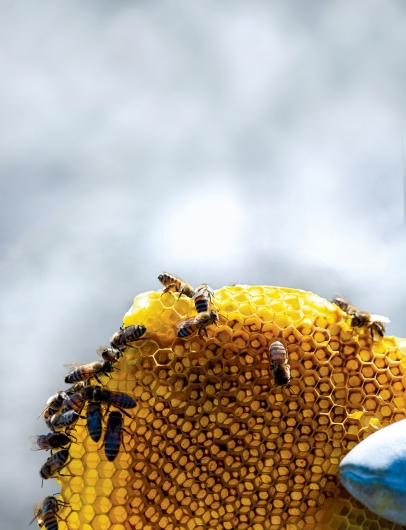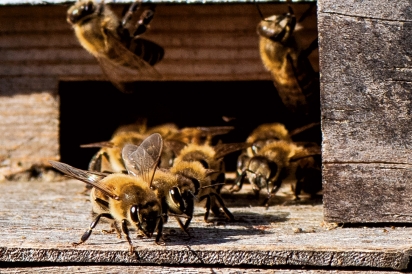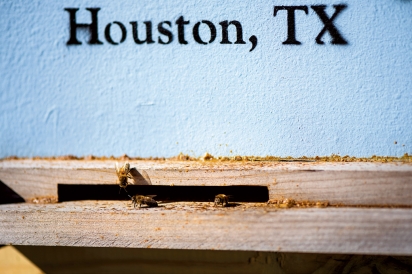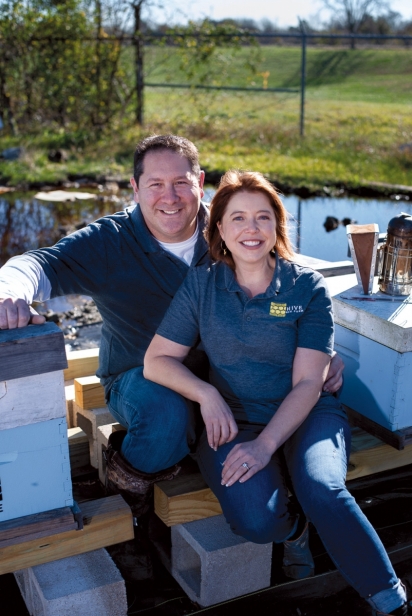Healing From the Hive
The blue Texas sky opens up above and sunshine peeks through the trees. There is a buzz in the air: the hum of thousands of bees dancing on the breeze. If you close your eyes the beating wings fill your ears with nature’s vibration. It’s spring in the apiary. From the little blue hives all in a row, bees are busily getting to work harvesting sun from millions of flowers.
Spring is probably the most important time for bees. After a long, cool (and likely wet) winter the queen has felt the turn of the earth and she can sense the bounty of blooms ready to emerge. She starts to build her colony by laying up to 2,000 eggs a day in preparation for the renewal of the land. The bees will spend all spring and most of the summer storing as much honey as possible so when fall arrives the colony can begin to prepare for the coming winter when there will be less to do, fewer flowers to harvest from and fewer bees in the hive. All in wait for the next season’s cycle. It is an amazing process to watch every year: the growth of the colony, harvesting of nature and, finally, the quiet of the colder months.
I’ve always been fascinated by bees. How they communicate, work together and the seasonal dance that plays out every year. Did you know bees communicate through smell? Imagine cracking open the top of a hive box and looking in to see it bustling with thousands of bees busy at work. Then the smell of ripe bananas wafts out. It is the bees’ alarm bell: They know we are here. Smoke is one of the tools we use as beekeepers to mask that alarm and distract the hive from our presence. One of the first tests for a newbie apiarist is to light the smoker— and keep it lit! Sounds easy? I’ve spent many mornings hunched over a smoker, puffing away and trying to nurture a spark into a flame like a game of survivor—only to see it go out the moment I get to the hives.
Thousands of stinging insects with barbed butts are probably not everyone’s idea of good pets. My partner Cyrus Nasr and I came to it through our love of gardening and sustainable healthy food. My zen is the garden—hands in the ground with dirt under my nails. I’m a seed hoarder and am always testing my green thumb on flowers and vegetables in our small plot in Garden Oaks. Watching the bees and butterflies flit and bobble from flower to flower is delightful. Cyrus loves cooking and uses the best local goods from farmers we know, supporting those who work toward a healthy food system. It spurred our curiosity about how we could do the same. Keeping bees was an easy choice, a way to contribute to our own little healthy food ecosystem and to help protect these invaluable pollinators that are endangered in so many ways.
Throughout the year we watch them forage, coming and going with bundles of pollen and stomachs of nectar. In a strong “flow,” when the flowers are bursting with resources, the bees can put away 100 pounds of honey or more. Starting in the spring we rotate through the apiaries every two weeks, checking on their progress to make sure they don’t run out of precious room for all that honey, adding more and more boxes along the way. Harvest time in early summer and late fall is a busy time. You will see us bringing boxes upon boxes of honey-heavy frames and cassettes home. The gooey stickiness gets on everything. We leave the hives with a box of honey for the bees to use throughout the fall and winter when there is not food available so they will be strong and ready for the next spring.
Our honey squares are unique in that the bees build directly onto them on the hive. Once harvested, all we need to do is put a lid on them (literally). From the frames we cut large sections of beautiful honeycomb for our restaurant clients and the odds/ends that are not as pretty end up in our honey press. It’s where we crush out the golden sweetness from the comb and bottle it. The ripples of honey cascading from the honey press are mesmerizing. We also use the leftover beeswax to pour beautiful yellow beeswax candles, whose flames light up our dining room in warm glow.
In order to make this honey magic happen we partner with organic farms all in and around Houston, like Hope Farms in South Houston (part of Recipe for Success), Laughing Frog Farm in Hempstead and The Sanctuary Blueberry Farm in Montgomery. This partnership supports the pollination of the many types of vegetables and flowers our farmers grow as well as provides healthier environments for our honey bees (not to mention tasty multi-variety honey). In addition, unlike most commercial operations we do not move our colonies from location to location or use chemicals to treat them (both of which stress the bees). Instead, our first priority is to create the best environment for the bees, which will yield the highest-quality honeycomb.
It’s a win-win all around, bees included.
In addition to supporting our honey bees we also have a strong passion for apitherapy, or using the products of the beehive for our health. Did you know that a beehive is similar to your own medicine cabinet? For over 5,000 years people have been using bee products for holistic medicinal purposes, from ancient Egyptian, Greek and Chinese medicine to now.
Honey is one of the most amazing products made by bees and the one we are all most familiar with. But honey is not just good for sweetening your tea or that lovely buttermilk biscuit. Honey has powerful antibacterial qualities similar to the tube of Neosporin in your med kit. If you are like me you put that stuff on all those scratched knees, elbows and cuts over the years. Honey is the perfect alternative and can be applied to skin cuts or irritations to soothe the skin, promote healing and discourage infection. Medical-grade honey is regularly used in wound care in hospitals. The slightly acidic pH level of honey is what helps prevent the growth of bacteria, while its antioxidant elements clean up free radicals that are linked to diseases.
Raw local honey has also been widely used to help support individuals who suffer from environmental allergies. By ingesting local honey the body is able to develop immunities to decrease allergic responses. Other benefits include reducing acid reflux and other gastrointestinal issues, decreasing cold/ flu symptoms and infections. When combined with pollen, another product bees collect, it becomes a superfood (protein + carbohydrates) that can give you sustained energy throughout the day. We call it Bee Butter and suggest taking it in the morning, afternoon or after a hard workout. It has all the nutrients a healthy body needs, like amino acids, vitamins and minerals, but none of the negative effects of sugar, caffeine or highly processed foods. It tastes like a spoonful of sweet flowers.
Propolis is another product from the bee medicine cabinet. It is made by bees through the collection of tree resin or sap with a mixture of beeswax and other components. In the beehive it is used like sticky putty to sterilize the inside of the hive and fill in any gaps in the boxes or frames. The key element in this medicinal powerhouse are polyphenols: antioxidants that fight disease and damage in the body. Historically propolis was used to treat abscesses and fight wounds or tumors. Today it’s even being use as a complementary therapy for certain cancers. It has specific antifungal and anti-inflammatory properties that may be beneficial in burns, oral healing and other viral issues like cold sores—your own Oragel.
Perhaps the most interesting medicinal tool is the bee sting itself (I know, ouch). Bee venom therapy has a long history and is used frequently in European and Eastern medicine practices. Although not recognized as a medical practice in the United States many individuals raise bees or seek out bees to support their health in this way. Bee venom contains melittin and apamin, which promote healing and anti-inflammatory responses in the body. Studies have shown this can be beneficial to individuals with arthritic symptoms, viral infections (such as shingles), bacterial infections (such as Lyme disease) and autoimmune disorders (such as multiple sclerosis). But that does not mean you should go jump on a beehive for anything that ails you. There are many safety protocols and procedures in a bee venom therapy (BVT) journey. Next time you do happen to be stung, consider it a little dose of health.
If these bee-made wonders have you curious there are many others: pollen, royal jelly, beeswax and even bee air can be used for their health benefits. As you start your new “bee year” we encourage you to explore these and the many other ways a healthy lifestyle and healthy choices can build a better you.
Disclaimer: The information above is meant to inform and educate readers on the potential benefits of the products of bees and the hive. Bee venom therapy is not recognized as a medical practice in the United States and the authors are not medical clinicians.
Check out Hive Bee Farm and follow them on Facebook for more about the health benefits of bees, local honey harvests and workshop opportunities to learn more about the amazing honey bee.









